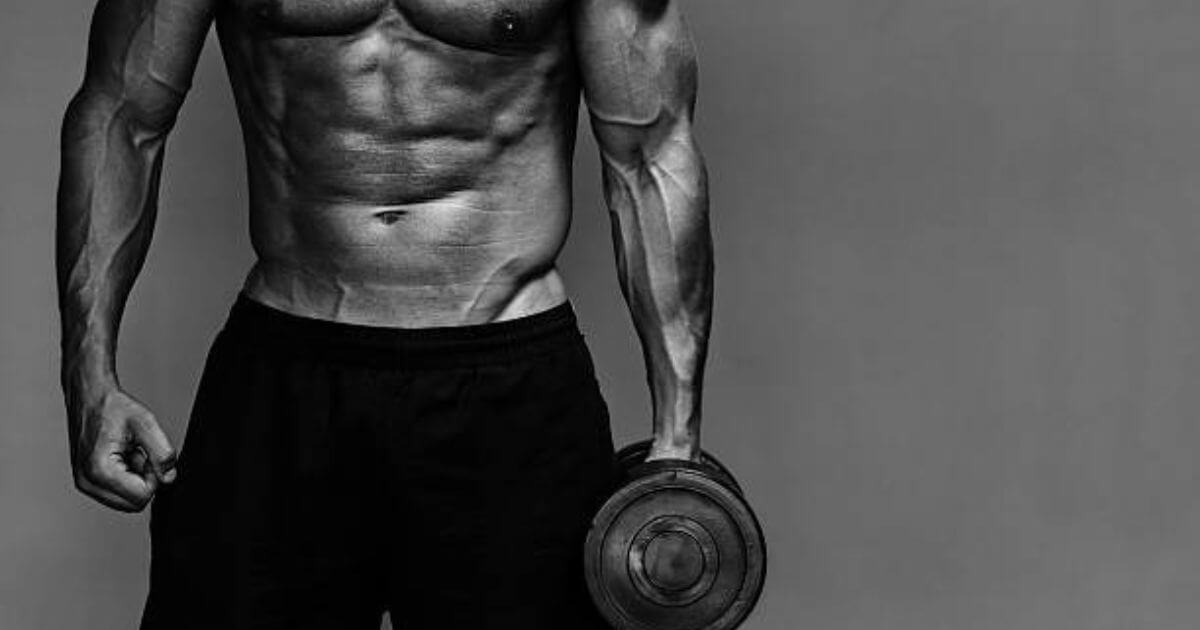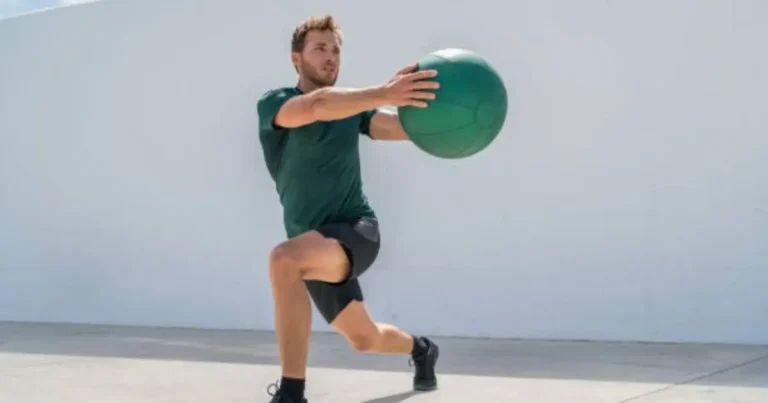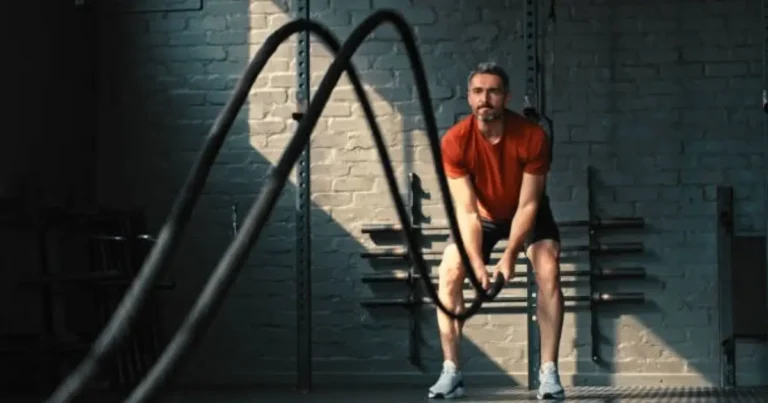The Ultimate Calisthenics Upper Body Workout (Build Strength & Muscle at Home)
Dreaming of a strong, sculpted upper body you can work on anywhere? With this calisthenics upper body workout, you’ll harness your own bodyweight to develop muscle, power, and endurance—no gym required. From push-ups to pull-ups, this guide covers beginner, intermediate, and advanced routines along with essential training principles and progressions.
Introduction
Imagine waking up in four weeks with noticeably stronger arms, a fuller chest, and the confidence to tackle pull-ups on the nearest bar. Whether you’re tight on space, budget, or equipment, a focused upper body workout no equipment plan can deliver remarkable results. This guide provides:
- A muscle-by-muscle overview and movement breakdown
- Core training principles for safety and effectiveness
- Level-based routines (Beginner ➔ Intermediate ➔ Advanced)
- A comprehensive exercise library with regressions and progressions
- Warm‑up, mobility, and recovery protocols
Ready to transform your upper body using nothing but your own strength? Jump to your level or read on for the full roadmap.
Table of Contents
Understanding Your Upper Body Muscles & How Calisthenics Hits Them
To train intelligently, know what muscles you’re targeting:
- Chest (Pectoralis Major & Minor): Pressing movements like push-ups and dips.
- Back (Lats, Traps, Rhomboids): Pull-ups, inverted rows, bodyweight pulls.
- Shoulders (Deltoids): Push-ups, pike presses, dips.
- Arms (Biceps, Triceps): Chin-ups, diamond push-ups, dips.
- Core (Abs, Obliques): Stabilizes for every movement.
Compound calisthenics moves engage multiple muscle groups simultaneously, building functional strength and core stability in every rep.
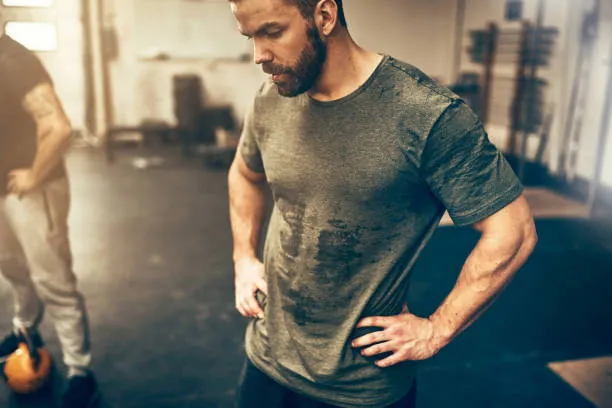
Core Principles for Effective Calisthenics Upper Body Training
Master the Form
Quality over quantity. Focus on full range of motion, controlled tempo, and joint alignment to protect wrists, elbows, and shoulders.
The Push-Pull Balance
Balance pressing (push-ups, dips) with pulling (rows, pull-ups) both horizontally and vertically. This ratio (e.g., 2:1 pull-to-push volume) maintains joint health and muscle symmetry.
Progressive Overload
Continuously challenge your muscles by increasing:
- Leverage: Adjust body angle for easier or harder variations.
- Rep/Set Volume: Add reps or additional sets.
- Tempo: Slow negatives or paused reps.
- Instability: Use rings, single-arm drills, or deficit platforms.
Mind-Muscle Connection
Slow down, concentrate on the target muscle, and visualize the contraction to maximize activation.
Frequency & Recovery
Beginners: 2–3 upper body sessions/week. Intermediate/Advanced: 3–4 sessions with adequate rest. Prioritize sleep, nutrition, and active recovery for best gains.
Essential Upper Body Warm-Up & Safety Considerations
Why Warm-Up?
Prepares joints, raises muscle temperature, and reduces injury risk.
5-7 Minute Dynamic Warm-Up
- Arm Circles: 30s forward/backward
- Cat-Cow: 10 reps
- Thoracic Rotations: 10 each side
- Band Pull-Aparts/Dislocates (optional): 2×15
- Scapular CARs: 2×10
- Wrist Circles: 30s each direction

[Watch the follow-along warm-up video]
Listen to Your Joints
Any sharp pain means stop. Modify or regress the movement.
Find Your Level: Which Upper Body Workout Suits You?
Push-Up Test: How many full push-ups? 0–5 = Beginner, 6–15 = Intermediate, 16+ = Advanced.
Pull-Up Test: Can you perform a negative or rep? Use regressions accordingly.
(See flowchart below to choose your starting routine.)
Beginner Calisthenics Upper Body Workout
Goal
Build foundational strength, master basic push and pull forms.
Routine (2–3x/week)
| Exercise | Sets | Reps | Rest |
|---|---|---|---|
| Incline Push-Ups | 3 | 8–12 | 60–90s |
| Table/Towel Rows | 3 | 6–10 | 60–90s |
| Scapular Push-Ups | 2 | 10–15 | 45–60s |
| Bench Dips (feet on floor) | 2 | 8–12 | 60–90s |
| Plank (elbows) | 3 | 20–30 sec | 60s |
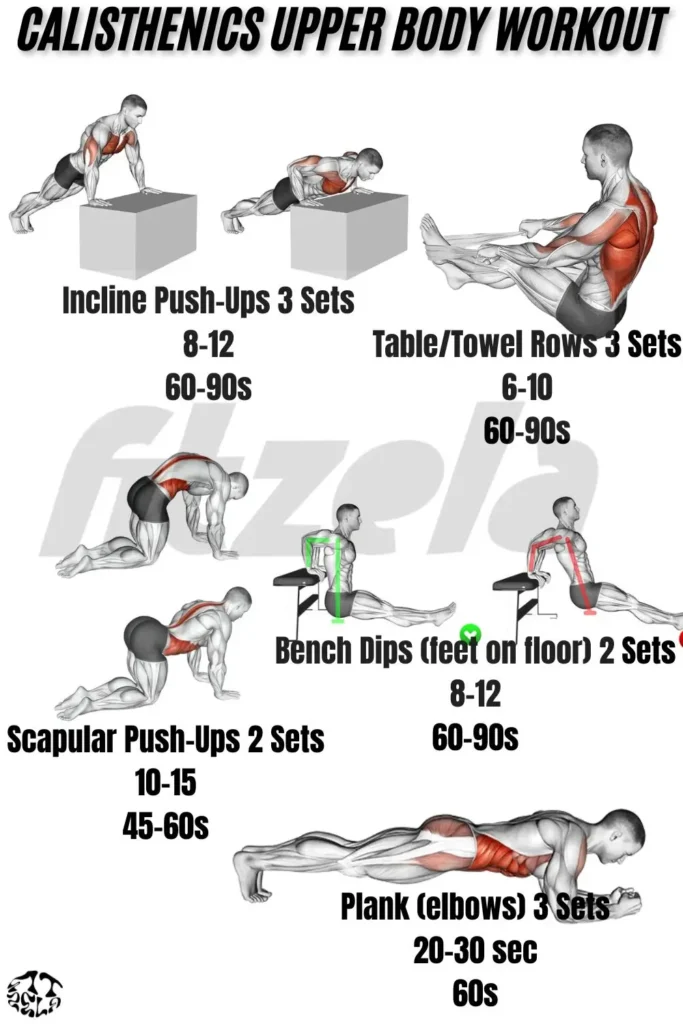
Progression: Decrease incline, increase reps, or move to floor push-ups when comfortable.
Intermediate Calisthenics Upper Body Workout
Goal
Master standard push-ups and dips, build pull-up strength.
Routine (2–3x/week)
| Exercise | Sets | Reps | Rest |
| Standard Push-Ups | 4 | 10–15 | 60s |
| Australian Pull-Ups | 4 | 8–12 | 60s |
| Pike Push-Ups | 3 | 6–10 | 60s |
| Parallel Bar Dips (or bench) | 3 | 6–10 | 60–90s |
| Pull-Up Negatives / Band-Assisted Pull-Ups | 3 | 4–8 | 60s |
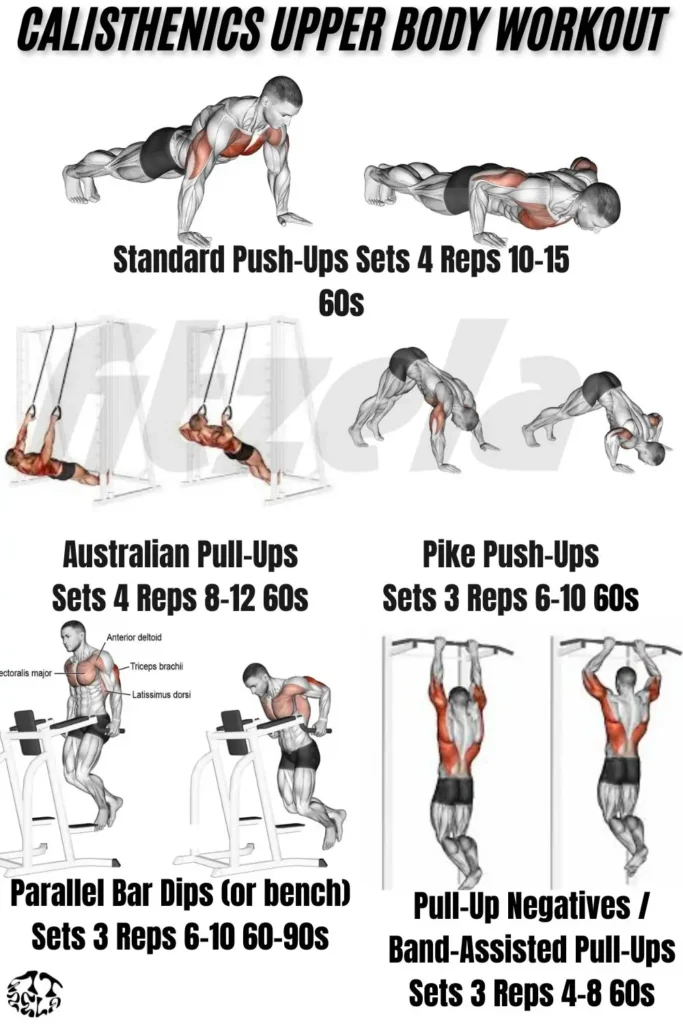
Skill Focus: Work toward unassisted pull-ups and full dips by reducing assistance and increasing volume.
Advanced Calisthenics Upper Body Workout
Goal
Achieve advanced skills (pull-ups, dips, HSPUs), and build noticeable muscle.
Routine (3–4x/week)
| Exercise | Sets | Reps | Rest |
| Weighted Pull-Ups or Archer Pull-Ups | 4 | 4–6 | 90s |
| Ring Dips or Weighted Dips | 4 | 6–8 | 90s |
| Handstand Push-Up Variations | 3 | 3–5 | 2–3 min |
| Pseudo Planche Push-Ups | 3 | 6–10 | 90s |
| Muscle-Up Transitions (optional) | 3 | 4–6 | 2 min |

Programming Tip: Cycle between strength (low reps) and hypertrophy (higher reps). Incorporate deload weeks.
The Calisthenics Upper Body Exercise Library
Organized by movement pattern:
Horizontal Push (Push-Ups)
- Incline, Standard, Decline, Archer, Clap variations.
Vertical Push (Dips/HSPUs)
- Bench Dips, Parallel Bar Dips, Pike Push-Ups, HSPUs.
Horizontal Pull (Rows)
- Table Rows, Australian Pull-Ups, Archer Rows.
Vertical Pull (Pull-Ups)
- Band-Assisted, Negative, Standard, Archer, Weighted.
Arms & Accessory
- Diamond Push-Ups, Banded Bicep Curls, Triceps Extensions.
Each exercise entry includes:
- Primary muscles worked
- Step-by-step instructions
- High‑quality image/GIF
- Common mistakes and fixes
- Regressions & progressions
Don’t Forget Your Arms! Calisthenics for Biceps & Triceps
Triceps: Diamond push-ups, dips, pike presses. Biceps: Chin-ups, rows, bodyweight curl variations using towels or rings.
Optional accessory: Ring curls, triceps extensions on wall/chair.
Structuring Your Week: Upper Body Training Splits
- Full Upper Body (2–3x/week): Balanced routine each session.
- Upper/Lower Split: 2x upper, 2x lower.
- Push/Pull/Legs Split: 1x push, 1x pull, 1x legs per cycle.
Choose based on your schedule and recovery capacity.
Upper Body Cool-Down & Stretching
- Doorway Chest Stretch – 30s each side
- Hanging or Side Bend for Lats – 30s
- Cross‑Body Shoulder Stretch – 30s
- Triceps Stretch – 30s
- Wrist Flexor/Extensor Stretch – 30s each
Include these after every session to promote mobility and recovery.
Frequently Asked Questions (FAQ)
Can I build significant upper body muscle with calisthenics? Yes—by using progressive overload, varied angles, and sufficient volume paired with proper nutrition.
How often should I train my upper body? 2–4 times weekly, depending on your level and recovery.
What if I can’t do pull-ups or dips yet? Use regressions like negative reps, band assistance, or table rows until you build strength.
Is this enough for my arms? Compound moves work arms effectively; add isolation only if needed for extra focus.
How do I balance push and pull exercises? Aim for a 1:1 or 1:2 push-to-pull ratio to keep shoulders healthy.
Conclusion: Build Your Upper Body Powerhouse with Calisthenics
A balanced calisthenics upper body workout routine unlocks strength, muscle, and functional fitness—with zero equipment. Focus on form, progression, and recovery. Bookmark this guide, download the workout sheet, and start crafting the upper body of your dreams—today!


